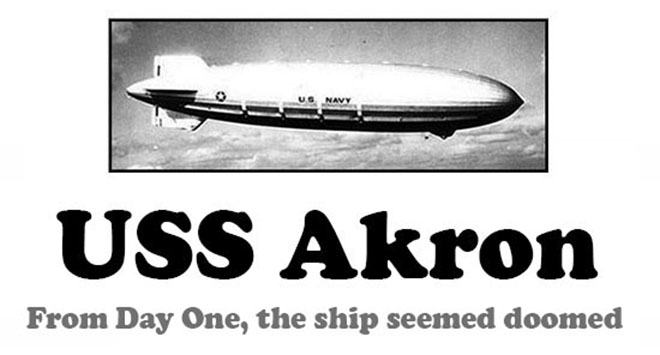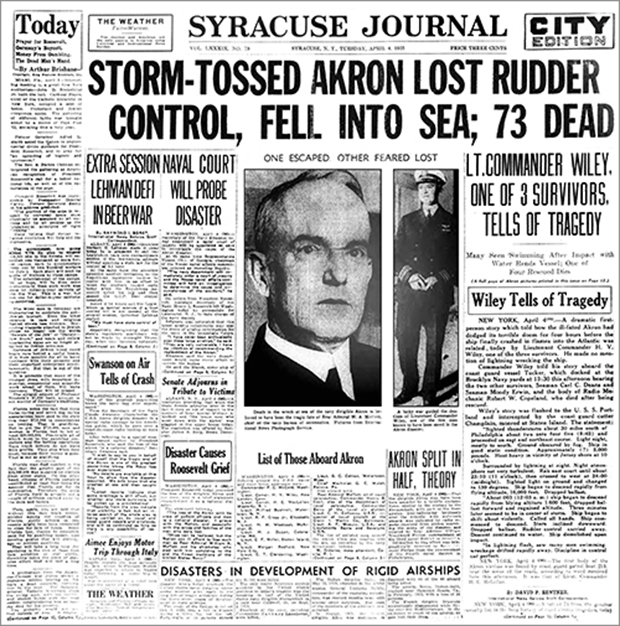
|
 |
Syracuse Journal, April 4
NEW YORK (INS) — The disaster which today overtook the United States naval dirigible Akron added another grim mark to the long list of tragic accidents during the years of development in rigid airships.
The crash of the British R-101 on October 5, 1930, into a hill in France during a thick fog led the list. Forty-eight of 53 persons aboard the R-101 were killed.
The only major American airship accident in the United States previous to today’s tragedy was the breaking in half of the navy dirigible Shenandoah in a gale near Caldwell, Ohio, on September 3, 1925. Fourteen of the crew were killed.
The Italian dirigible, Italia, on May 25, 1928, exploded in the Arctic. General Umberto Nobile, commander of the exploring expedition, was rescued months later with several other survivors, but most of the airship’s crew perished.
In August, 1921. the British dirigible ZR-2 was destroyed in England, with 44 of the 49 aboard being killed.
The airship Roma, Italian-built, crashed near Hampton Roads, Virginia, in February, 1922, with a loss of 34 persons.
The French dirigible Dixmude mysteriously disappeared while flying over the Mediterranean. In the explosion or crash of the airship, 50 men lost their lives. |
|
| |
Syracuse Journal, April 4
By DAVID P. SENTNER
NEW YORK (INS) — A toll of 73 lives, the greatest casualty list in the history of rigid airship tragedies, today appeared written across the sky in the crash of the United States naval dirigible Akron into the sea off Barnegat light on the New Jersey coast.
While more than one hundred vessels and planes of the Navy and Coast Guard hopelessly continued their search for survivors, the Coast Guard destroyer Tucker brought the only three living rescued members of the airship’s crew into New York Harbor.
They alone carried the story of the mighty airship’s losing battle with the lightning and a terrific wind-lashed storm which tossed the ship like an eggshell and finally flung it stern-first to crash upon the sea.
In a series of messages from the German tanker Phoebus, which picked up the four living air sailors, one of them dying later; in the pieces of description told their rescuers by the rescued ones, from the story of a fisherman eyewitness who saw the grim antics of the stricken dirigible, what happened in the horror of lightning, blackness and whirlpool air currents above the clouds can be told.
The dirigible Akron crashed and then caught fire, according to Lieut. Commander H. V. Wiley, second in command of the ship.
A radioed report to the Navy Department in Washington from the cruiser Portland shortly before 9 o’clock this morning said Lieutenant Commander Wiley was unable to give any reason for the crash.
“The Portland is maintaining the position of the Phoebus. The Mojave, McDougal, Hunt and Cole are searching. Also two Coast Guard planes. The Portland has covered most of the probable area en route to the present position.
“The Tucker reports that the Akron crashed and then caught fire. She was in a severe electrical storm. Lieutenant Commander Wiley gives no reason for the crash. Wiley and two enlisted men and the body of the radio operator, Copeland, are en route to New York aboard Tucker. Visibility now about three miles.”
The first bit of wreckage was picked up this morning by the Coast Guard destroyer McDougal, according to reports received here. It was a length of tubular piping which was covered with kapok, a satiny, waterproof fiber. It was found one mile north of where the U. S. cruiser Portland had been searching all morning for traces of the Akron.
Cruising serenely and smoothly through a summer-like night sky, the airship was struck with little warning by the out-of-season thunder and lightning storm. Crew members not on duty were in their bunks.
When the first streak of lightning shot across the Akron’s bow, all hands were called to their emergency posts. The ship headed for land to avoid the air currents suddenly born into life over the water.
Rear Admiral William A. Moffett, chief of the naval bureau of aeronautics, one of several high-ranking naval officers riding as passengers, was aboard. Others were Commander H. B. Cecil, Commander F. T. Berry and Col. A. F. Mausry, one of the Ordnance Reserve, U. S. Army, all passengers on the last trip of America’s air queen. |
|
| |
Syracuse Journal, April 4
NEW YORK (INS) — The Akron has been followed by a “jinx” since she made her first actual flight at Akron, Ohio, where she was built, on September 23, 1931.
Lieutenant Commander Charles E. Rosendahl survivor of the crash of the United States naval airship Shenandoah over Ohio in 1925, in which 14 lives were lost in a squall, commanded the Akron on this first flight.
An alleged Communist was charged with attempting to leave out rivets to weaken the construction of the Akron during the time it was being built at the Goodyear-Zeppelin Corporation dock at Akron.
As the giant airship neared completion, it was announced the ship would be about 19,000 pounds heavier than the prescribed specifications.
Rear Admiral Moffett explained this as “a direct conversion into increased safety and military factors.”
He said the overweight would not seriously affect her general air worthiness.
While the Akron was being groomed at Lakehurst on February 21, 1932, for a flight with a congressional subcommittee to demonstrate the airworthiness of the dirigible, a sudden gust of wind lashed it into the ground and damaged its fabric and vertical fin.
The congressional flight was called off.
A month previous, the giant naval airship had torn loose from the mast of the naval tanker Patoka in Norfolk, Virginia, during maneuvers. The Akron was reported not to have suffered any damage.
Another minor accident occurred in the second week of March, 1932, while the Akron was undergoing repairs in her hangar at Lakehurst. A storm blew in a pane of heavy glass, which cut through the top fabric of the airship and tore open a gas cell.
But it was on its first major training flight — a cruise to the Pacific Coast — during May of 1932 that the Akron recorded its first casualties.
The ship coast between $5,000,000 and $6,000,000 to construct.
After making it through hazardous storms over Texas, the airship reached California, but in an attempt to land, two men of the mooring crew at Camp Kearney were hurled to their deaths, while a third saved his life by clinging to the end of a 300-foot rope for two hours.
Among the Akron’s ultra-modern improvements was the innovation of being able to carry five fast single-seat biplanes attached to the ship. By means of a trapeze arrangement underneath the dirigible, the planes could be taken aboard while the ship was in flight.
The Akron made a spectacular trip to New York City on November 2, 1931, carrying 109 passengers. |
|
| |
Reporters seemed surprised that Lieutenant Commander Herbert V. Wiley, one of the three survivors, did not mention lightning in his account of the disaster. Wiley gave a statement to naval officials and also wrote a story for newspapers.
It turned out that Wiley was correct in believing the Akron was never struck by lightning. His theory was the ship had encountered a strong downward current of air that caused the fatal plunge. A naval board of inquiry reached the same conclusion.
The board absolved the airship's crew from any responsibility for the disaster, but faulted Commander Frank C. McCord for an error in judgment "in not setting such courses that would have kept him in a safe semi-circle, thereby probably avoiding the several conditions finally encountered, and that his error in judgment was a contributory cause of the loss of the Akron.
A day after the Akron disaster, a blimp sent out to look for bodies malfunctioned and crashed in Barnegat Light, killing two crew members.
One year later, Wiley was the commanding officer on the USS Macon when it was lost in a storm off Port Sur, Calif., killing two crew members. Wiley survived, but that was it for him and airships.
|
|
| HOME • CONTACT |
| |
|

